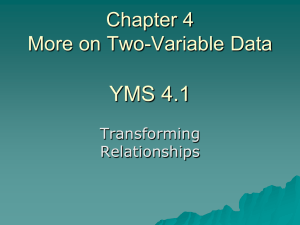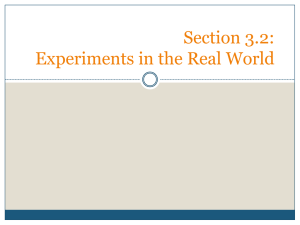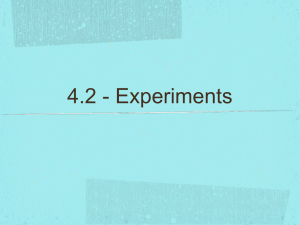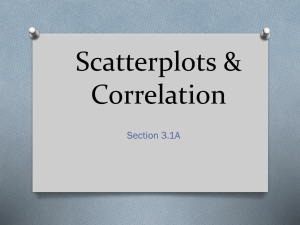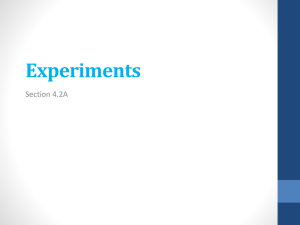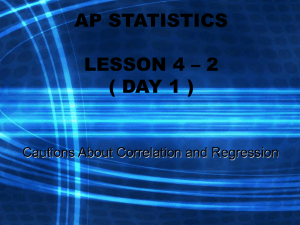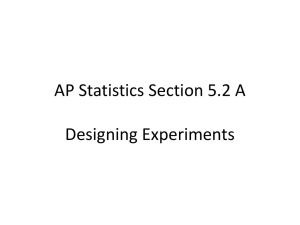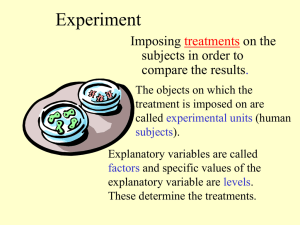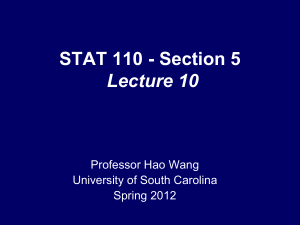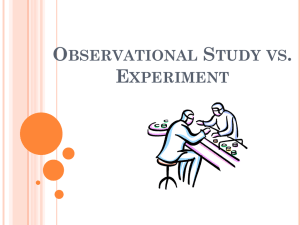day9 - University of South Carolina
advertisement
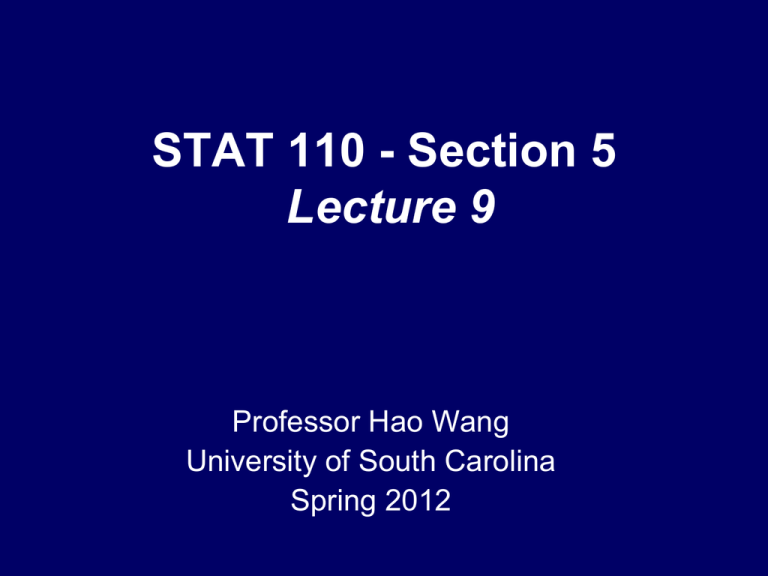
STAT 110 - Section 5 Lecture 9 Professor Hao Wang University of South Carolina Spring 2012 Thought Question 1: In a study to relate two conditions, researchers often define one as the explanatory variable and other as the outcome or response variable. In a study to determine whether surgery or chemotherapy results in higher survival rates for a certain type of cancer, whether the patient survived is one variable, and whether he or she received surgery or chemotherapy is the other. Which is the explanatory variable and which is the response variable? Thought Question 2: In an experiment, researchers assign “treatments” to participants, whereas in an observational study, they simply observe what the participants do naturally. Give an example of a situation where an experiment would not be feasible for ethical reasons. Thought Question 3: Interested in determining whether a daily dose of vitamin C helps prevent colds. Recruit 20 volunteers, want half to take vitamin C and other half to agree not to take it. Ask each which they prefer, and ten say take vitamin and other ten say not. Ask each to record how many colds he or she gets during the next ten weeks. At end of time, compare the results reported from the two groups. Give 3 reasons why this is not a good experiment. Thought Question 4: When experimenters want to compare two treatments, such as an old and a new drug, they use randomization to assign the participants to the two conditions. If you had 50 people participate in such a study, how would you go about randomizing them? Why do you think randomization is necessary? Why shouldn’t the experimenter decide which people should get which treatment? Defining a Common Language Explanatory variable is one that may explain or may cause differences in a response variable (or outcome variable). Example: Study found that overall left-handed people die at a younger age than right-handed people. Explanatory = Handedness Response = Age at death A treatment is one or a combination of categories of the explanatory variable(s) assigned by the experimenter. Example: meditators/vegetarian and speed of aging process Two Explanatory Var. = meditator or not; vegetarian or not; Four treatments: (Med,Veg) (Med, Non-veg) (Non-med, non-veg), (Not Med, Non-veg) Response = speed of aging Example You are planning an experiment to study the effect of gasoline brand and vehicle weight on the gas mileage (miles per gallon) of sport utility vehicles. In this study, A. Gas mileage is the response variable. B. Gas mileage is an explanatory variable. Example You are planning an experiment to study the effect of gasoline brand and vehicle weight on the gas mileage (miles per gallon) of sport utility vehicles. In this study, the explanatory variable(s) is(are) A. Miles per gallon B. Sport utility vehicles C. Gasoline brand D. vehicle weight E. (C) and (D) The study includes three vehicle weights and three brands of gasoline, so there are: A. Two treatments and six explanatory variables B. Two treatments and nine explanatory variables C. Two explanatory variables and six treatments D. Two explanatory variables and nine treatments Problems in Experiments lurking variable – a variable that has an important effect on the relationship among the variables in a study but is not one of the explanatory variables studied confounding – two variables are confounded when their effects on a response variable cannot be distinguished from each other confounded variables can be either explanatory or lurking Example: Lurking Variables Study of the relationship between smoking during pregnancy and child’s subsequent IQ a few years after birth. • Explanatory variable: whether or not the mother smoked during pregnancy • Response variable: subsequent IQ of the child • Women who smoke also have poor nutrition, lower levels of education, or lower income. • Possible Lurking Variables: Mother’s nutrition, education, and income. Example: Lurking variable • Consider wanting to compare the effectiveness of online business calculus classes to traditional in-class business calculus classes. • Two sections of the course, one online and on in-class, are scheduled for the semester. The students choose which class to sign up for. • The two classes are taught by the same teacher and take the same final exam at the end of the semester. The class with the higher average on the final will be declared to have had the better method. Example • What if the students who are less confident in their mathematical ability also dislike computers more (or want to see the instructor in person). • Maybe the average scores on a pre-calculus test for the two groups are online – 40.70 vs traditional – 27.64 which group do you think should do better? •The effect of online vs traditional instruction is mixed up with influences lurking in the background. • Here, student preparation (a lurking variable) is confounded with the explanatory variable. Example online vs traditional (explanatory variable) Causes? student preparation (lurking variable) test score after course (response variable) The influence of course setting can’t be distinguished from the influence of student preparation. Randomized Comparative Experiment randomized comparative experiment – compare the effects of a treatment on an experimental group to a control group • Subjects are randomly assigned to two groups – experimental and control. Randomized Comparative Experiment group 1 n1 subjects random allocation treatment 1 compare response group 2 n2 subjects treatment 2 The Logic of Experimental Design • Randomization produces groups of subjects that should be similar in all respects before we apply the treatments. • Comparative design ensures that influences other than the experimental treatments operate equally on all groups. • Therefore, differences in the response variable must be due to the effects of the treatments. Principles of Experimental Design • Control the effects of lurking variables on the response, most simply by comparing two or more treatments. • Randomize – use impersonal chance to assign subjects to treatments. • Use enough subjects in each group to reduce chance variation in the results. placebo – a dummy treatment with no active ingredients that is used to control for psychological effects, especially in medical experiments placebo effect – the response of patients to a placebo • Some subjects improve when taking placebo! Example: Quitting Smoking with Nicotine Patches Study Details: • 240 smokers recruited (all met entry criteria). • Randomly assigned to either nicotine patch or placebo patch for 8 weeks. All received counseling. • Why can not let them volunteer ? • After 8 weeks: 46% of nicotine group quit, only 20% of placebo group quit. • After 1 year: 27.5% of nicotine group quit, only 14.2% of placebo group quit. Source: Hurt et al., 23 February 1994 “What if we can’t Experiment?” or “How to Live with Observational Studies” • Good studies are comparative even when they’re not experiments. • We can use matching to control for lurking variables. • We can measure and adjust for confounding variables (by using statistical techniques). Example: Observational study Study of the relationship between smoking during pregnancy and child’s subsequent IQ a few years after birth. • Explanatory variable: whether or not the mother smoked during pregnancy • Response variable: subsequent IQ of the child • Women who smoke also have poor nutrition, lower levels of education, or lower income. • Possible Lurking Variables: Mother’s nutrition, education, and income.
